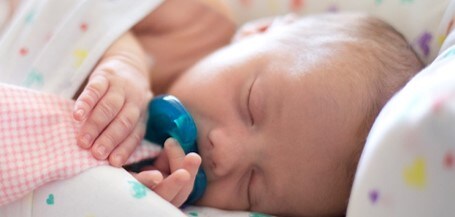Developmental Care: a mother’s experience
On July 9th, 2007, Nanine Blomstrom’s water broke in the 24th week of her pregnancy. Scared and uncertain, she and her husband rushed to NYU Langone Medical Center, where she remained for nearly two weeks. On July 20, her son Teddy was born at 25 weeks and 6 days. Teddy was 820 grams and 13 inches, had to be revived immediately, and was transferred to the NICU.
“All of the people on the NICU team were absolutely amazing. The whole world opened up to us that day. The experience changed our lives and our perspective on life because of the way the doctors and nurses handled it.”
Nanine Blomstrom
Healing environment In the months that followed, as Nanine learned about caring for her son, she also learned about Developmental Care in the NICU. A holistic approach to care, Developmental Care addresses the physiological and developmental needs of newborns. Staff focus on creating a neuroprotective, healing environment, that emphasizes partnering with families to support positioning and handling, safeguard sleep, minimize stress and pain, protect skin, and optimize nutrition. One aspect of this neuroprotective environment that Nanine noticed immediately was the minimization of light and sound. “The environment of the NICU was very dark, quiet, and personal, except for the beeping of the monitors. In my son’s pod they had the shades completely drawn and kept it very dark,” she says. “It was clinical but very peaceful. Even though it was an open floor, it was very intimate.”
Teddy in the NICU
The value of touch Nanine says skin-to-skin contact, or kangaroo care, was one valuable strategy that she learned from NICU staff. “They explained how to touch him without rubbing his delicate skin,” she explains. “We kangarooed as quickly as possible and Teddy immediately reacted to being on my chest. He put his hand up on my chin. He wanted to be there. It’s where his home was.” Learning continues after discharge When Teddy was discharged after 13 weeks in the NICU, Nanine continued to learn about Developmental Care. “I learned that the lighting, the way he was positioned, soft touch, the kangarooing, and swaddling all helped him have more of a connection to us and a softer entrance to the world,” she says.
Reaching out to other parents
Teddy at 3 years old
Her experiences led her to help other parents of preterm infants. She and her husband attended the NICU after-care program, which monitors the NICU graduates’ development until age two. There she learned about a support group for parents of preterm infants. She volunteered with the group for three years, which led her to a voluntary position with the Vermont Oxford Network (VON), an organization of NICU representatives from throughout the world that focuses on improving the quality of care for newborns and their families.
A positive approach to a harrowing experience Today, Teddy is a healthy little boy. Lingering effects from prematurity include Attention Deficit Hyperactivity Disorder (ADHD), as well as sensory processing issues. While he reacts strongly to loud sounds and some types of music, he also can play music by ear. He loves science, astronomy, reading, swimming, gymnastics, building with Legos, drawing, dancing, and Minecraft. Nanine continues to be a believer in the benefits of Developmental Care. “There is a balance to be had in treating the whole child as opposed to treating the symptoms,” she notes. “Developmental Care really helped me get over the anxieties of having a baby in the NICU. It was a positive approach to a very harrowing experience."
Teddy in 2016 at 8 years old
“Parents should know about this… You, as parents, are as much of the team as the nurses and doctors.”
Nanine Blomstrom
Return to Developmental Care page

Connecting with tiny patients: Implementing developmental care In addition to meeting the physical needs of infants in the NICU, it is also critical to meet their physiological and developmental needs. Our Integrative Developmental Care Model combines evidence-based best practices with core measures, and is one tool you can use to guide efforts to facilitate the physiological and developmental needs of each newborn.
